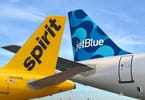When young people ask their parents, “What is a Pullman car?” they often receive a reply, “a railroad car you sit down in to have a meal on a train.” However, the full story of the invention and widespread usage of the Pullman car is much more interesting. You must go back to the development of the railroad sleeping cars by earlier pioneers than George Mortimer Pullman.
The first two companies to introduce sleeping cars were the Cumberland Valley Railroad in 1836 and the New York & Erie Railroad in 1843. Twenty years later, such cars were in wide use but they were uncomfortable and difficult to convert from day coach use into sleeping cars for night travel.
George Mortimer Pullman was born on March 3, 1831 in Albion, New York. Pullman’s father worked as a carpenter and as a building-mover when the Erie Canal was built. He invented a machine for transporting buildings on wheels for which he received a patent in 1841. His sons followed in his footsteps and gained renown as house-movers.
In connection with his business travel to and from Chicago, Pullman was familiar with uncomfortable sleeping accommodations on canal boats and railroad trains. Pullman and his associates formed a partnership and secured a contract from the Chicago, Alton, and St. Louis Railroad to develop a more comfortable sleeping car. In 1864, Pullman had a new car built in Chicago at a cost of US$20,000 and called it the “Pioneer.” It was a vast improvement over any car then in service with springs reinforced by blocks of solid rubber.
In 1867, George Pullman went even further in his market penetration. He recognized that the typical meal on a train consisted of hard tack beef, stale coffee, and doughnuts so hard they were called “sinkers.” Many travelers packed a portable lunch at home or purchased one at the station. One major exception was the Santa Fe, Atchison & Topeka’s association with the Fred Harvey Houses and the “Harvey Girls.”
Pullman created and introduced his first hotel on wheels, the President, a sleeper with an attached kitchen and dining car. The food rivaled the best restaurants of the day, and the service was impeccable. Subsequent Pullman sleeping cars offered first-rate service which was provided by recently-freed former house slaves who served as porters, waiters, chambermaids, entertainers, and valets all rolled into one person.
Pullman realized that if his sleeper cars were to be successful, he needed to provide a wide variety of services to travelers: collecting tickets, selling berths, dispatching wires, fetching sandwiches, mending torn trousers, converting day coaches into sleepers, etc. Pullman found that the former house slaves have the right combination of training, acquiescence, size, and color. He favored “the blackest man with the whitest teeth.” While Pullman was called a racist who “does more than any other organization in the world to make the Negro a beggar and a grafter” wrote the New York Press in 1911. “More negroes are demoralized each year by the Pullman Company than are graduated by Tuskegee, Hampton, and some other Negro educational establishments.” Truth is that Pullman was way ahead of his time. He became the biggest single employer of blacks in the country, and the job of Pullman Sleeping Car porter was probably the very best job that a black man could get in the post-Reconstruction era.
In 1869, the Pullman Company received nationwide publicity when the Union Pacific and the Central Pacific track laying crews met. In May 1870, the first through train from the Atlantic to the Pacific crossed the United States. The Pullman cars provided a level of comfort never before experienced. Magazines and newspapers extolled the marvels of the journey to the Pacific Ocean as “a six day’s sojourn in a luxurious hotel, past the windows of which there constantly flowed a great panorama of the American continent; thousands of miles in length and as wide as the eye could reach. Illustrated magazine articles which appeared telling the story of a trip to California had as many pictures of Pullman interiors as they had of the big trees of the Yosemite Valley. The tycoon Andrew Carnegie was so intrigued by Pullman that he became his largest investor.
By 1870, Pullman was manufacturing sleeping cars, drawing room cars, hotel cars, and dining cars. The hotel car had two drawing rooms each furnished with a sofa and two large easy chairs that converted to two double and two single berths at night. Each hotel car had a large kitchen which prepared fine food that compared favorably with the best restaurants of the day. The wonderfully compact, eight-foot square kitchen contained a specially-designed three-tier range which permitted baking, broiling, and boiling. Every inch of space was carefully designed for storage of kitchen equipment and supplies along with storage space for meats, vegetables, wines, and condiments. From this kitchen, the cooks were able to produce 250 meals per day.
During the 1880s, Pullman entered a related business: providing side-tracked sleeping cars in place of hotels for political delegates and convention attendees. For example, Pullman supplied 125 cars for the Grand Army of the Republic’s reunion in San Francisco plus 53 cars for the GAR’s event in Los Angeles. In addition, Pullman supplied 5 cars to Boston for the Grand Sovereign Lodge of Odd Fellows and 200 cars for the Knights Templars in St. Louis. By 1890, Pullman sleepers accommodated 100,000 people per night, more than all the nation’s top-notch hotels combined.
In the spring of 1893, a financial panic in the United States signaled the start of the 4-year depression which caused a severe decline in business activity. During the 1880s and 1890s many walkouts occurred at various Pullman factories. Under the leadership of the American Railway Union, a system-wide strike started on May 11, 1894. In short order, the strike turned ugly and violent. Pullman used his political influence to get public officials to call up 2,000 federal troops, 4,000 Illinois state militia, 5,000 deputy marshals, and the entire Chicago police force. The predictable outcome resulted in brick-throwing mobs overturning freight and Pullman cars which turned Chicago into a fiery inferno.
The Pullman strike finally ended after the summer of 1894 with the following consequences:
-twelve people were killed;
-the strikers were the big losers who had to end the strike with no concessions and no jobs;
-Eugene Debs, Clarence Darrow, and Jane Addams emerged with enhanced reputations; and
-President Grover Cleveland gained notoriety as a strike breaker.
The strike revealed and heightened awareness of the racial intolerance in both the Pullman company and the American Railway Union. In Pullman City, only a handful of black factory workers were given leases but none to Pullman porters. Black men worked as waiters in the Florence Hotel but few at the Calumet, Illinois, manufacturing facilities. The constitution of the American Railway Union stated that members must be “born of white parents.” No Pullman porters were invited to join the strike.
On October 19, 1897, George Pullman died of a massive heart attack at age 66. Pullman had earlier stipulated in detail exactly how he wanted to be buried in order to prevent possible desecration by disgruntled former employees.
His body lay in a lead-lined box that was wrapped in tar paper and coated with an inch of asphalt. The casket, lowered into a pit 13 feet long, 9 feet wide, and 8 feet deep, rested on a concrete flooring 18 inches thick. Once it was properly positioned, workers filled the space surrounding the casket with concrete to its upper lid. Covered by even more concrete, metal rods lay like a “wall of stone and steel” between Pullman and would-be grave robbers.
The image of a wealthy capitalist using the economic depression to browbeat his employees into submission stuck to Pullman for the rest of his life. Despite his extraordinary accomplishments as a pioneer of the assembly line and mass production, his conception and creation of a model company town, and his revolutionary creation of a “hotel on wheels” which revolutionized overnight travel, Pullman lost status, reputation, and personal health.
In a strange and unpredictable turn of fate, Robert Todd Lincoln, first-born son of Abraham Lincoln, worked as a lawyer, Secretary of War, and Ambassador to Great Britain. In 1893, he served as general counsel to the Pullman Car Company. When Pullman died in 1897, Lincoln became its President and later Chairman of the Board until 1922.
Article from Nobody Asked Me, But… No. 98 by Stanley Turkel, CMHS, ISHC. For more information about the author of this article, go to: www.stanleyturkel.com
WHAT TO TAKE AWAY FROM THIS ARTICLE:
- He became the biggest single employer of blacks in the country, and the job of Pullman Sleeping Car porter was probably the very best job that a black man could get in the post-Reconstruction era.
- Magazines and newspapers extolled the marvels of the journey to the Pacific Ocean as “a six day’s sojourn in a luxurious hotel, past the windows of which there constantly flowed a great panorama of the American continent.
- In 1864, Pullman had a new car built in Chicago at a cost of US$20,000 and called it the “Pioneer.






















